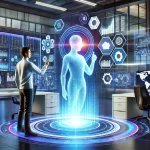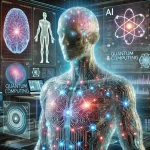
Diffusion Models in Science and Biology: Advancements in Text-to-Image Generation and AI Art
February 15, 2024Introduction to Diffusion Models
Diffusion models are a class of generative models used in machine learning and artificial intelligence to generate realistic images from textual descriptions. They operate by iteratively adding noise to an image until it matches the desired description. This process is based on the concept of diffusion, where the noise level is gradually reduced over time, allowing the model to generate high-quality, photorealistic images.
The evolution of diffusion models has seen significant advancements in recent years. DALL·E, developed by OpenAI, was one of the first models to demonstrate the potential of diffusion models in generating images from textual descriptions. Building on this, DALL·E 2, Imagen, and Stable Diffusion have further improved the quality and efficiency of image generation, making diffusion models a promising approach for creative AI applications.
Diffusion models are important in various fields, including graphic design, art, and entertainment, as they provide a powerful tool for generating visual content from textual descriptions. They can be used to create illustrations, animations, and other visual media based on user input, opening up new possibilities for creative expression and design.
Capabilities of Diffusion Models
Diffusion models have several key capabilities that make them valuable in various applications:
- Text-to-Image Generation: Diffusion models excel at generating high-quality images based on textual descriptions. They can translate written prompts into detailed and realistic visual representations, enabling the creation of images that match specific descriptions.
- Deepfakes: Diffusion models can be used to create deepfake images and videos, where AI-generated content is used to manipulate or replace elements in existing media. This technology has applications in entertainment, visual effects, and digital art.
- AI Art: Artists and creators can use diffusion models to explore new forms of creativity and aesthetics. By inputting abstract or specific prompts, artists can generate unique and innovative artworks that blend human creativity with AI-generated content.
Overall, diffusion models represent a significant advancement in generative AI, offering powerful tools for image generation and creative expression.
Ethical and Creative Ownership Considerations
Ethical and creative ownership considerations are crucial when dealing with AI-generated content and deepfakes created using diffusion models:
- Ethical Implications: The use of AI-generated content, particularly deepfakes, raises ethical concerns regarding misinformation, privacy violations, and potential misuse for malicious purposes. It’s important to establish guidelines and regulations to mitigate these risks.
- Creative Ownership and Attribution: Determining the ownership of AI-generated artworks can be complex. While the AI model creates the artwork, the input and guidance of the human creator play a significant role. Clear guidelines and agreements are needed to address issues of authorship, ownership, and attribution in AI art.
- Bias and Fairness: AI models, including diffusion models, can inherit biases present in the training data, leading to biased or unfair outputs. It’s essential to address these biases through diverse and representative training data, as well as careful monitoring and evaluation of the model’s outputs.
By addressing these considerations, we can ensure that the use of diffusion models and AI-generated content remains ethical, respects creative ownership, and minimizes potential biases and harms.
Applications in Science and Biology
Diffusion models have several applications in science and biology, particularly in visualizing complex scientific concepts and data:
- Visualizing Scientific Concepts: Diffusion models can generate photorealistic images based on text descriptions, helping scientists and educators illustrate abstract concepts such as molecular structures, biological processes, and astronomical phenomena.
- Supporting Scientific Illustration: These models can assist scientific illustrators in creating accurate and detailed visuals for research papers, presentations, and educational materials. They can enhance the clarity and impact of scientific communication.
- Enhancing Education and Public Engagement: AI-generated images can make scientific concepts more accessible to a wider audience, including students, educators, and the general public. They can be used in educational resources, museum exhibits, and science communication efforts to engage and educate people about scientific topics.
By leveraging diffusion models in these ways, scientists and educators can enhance the visualization and communication of scientific concepts, leading to a better understanding and appreciation of science and biology.
Challenges and Future Directions
Ensuring the ethical use of diffusion models in image generation is a critical challenge. As these models become more sophisticated, there is a growing concern about their potential misuse, such as creating deepfakes or generating misleading content. Researchers and developers need to implement safeguards and guidelines to mitigate these risks and promote responsible use.
Improving realism and diversity in AI-generated images is another key challenge. While diffusion models can produce impressive results, there is room for improvement in terms of generating images that are indistinguishable from real photos and ensuring a diverse range of outputs. Continued research and development efforts are needed to enhance the quality and diversity of AI-generated images.
In terms of future directions, there is a growing interest in exploring new frontiers in AI art and creative expression. Artists and researchers are experimenting with diffusion models to create innovative artworks and explore new forms of creative expression. This includes using AI to generate art that challenges traditional notions of creativity and explores the boundaries of what is possible with machine-generated art.
Case Studies and Examples
Examples of AI-generated images in scientific research and communication include the visualization of complex scientific concepts, such as molecular structures or biological processes, using AI-generated images. These images can help researchers and educators convey complex information in a more accessible and engaging way.
The impact of diffusion models on visual representation in science and biology is significant. These models enable researchers to create highly realistic and detailed images of biological structures, such as cells or organisms, that can be used for research, education, and communication purposes. This has the potential to revolutionize the way we visualize and understand the natural world, opening up new possibilities for scientific discovery and communication.
Community and Public Discourse
Discussions on AI art often revolve around its novelty, the creativity of AI algorithms, and the implications for the future of art and creativity. There’s also a focus on the role of AI-generated images in society, including their potential impact on jobs, creativity, and human-machine collaboration. Public perception of AI-generated images varies, with some viewing them as innovative and exciting, while others express concerns about authenticity, creativity, and the ethical implications of AI in art and society. Engaging with these topics can help raise awareness, foster dialogue, and shape the ethical and societal implications of diffusion models and AI art.
Future Directions in Diffusion Model Research
Advancements in Model Architecture and Training Techniques:
- Scalability and Efficiency: Future research in diffusion models aims to improve scalability and efficiency, enabling the generation of high-quality samples with lower computational resources. This involves developing more efficient sampling algorithms and model architectures that can handle larger datasets and higher resolutions.
- Model Interpretability: Another area of focus is improving the interpretability of diffusion models. Researchers are exploring techniques to understand and visualize the learned representations, making them more accessible and useful for downstream tasks.
- Incorporating Long-Range Dependencies: Current diffusion models typically focus on capturing short-range dependencies in data. Future research aims to develop models that can effectively model long-range dependencies, enabling the generation of more coherent and contextually rich samples.
Integration of Diffusion Models with Other AI Technologies:
- Combining with Reinforcement Learning: Researchers are exploring the integration of diffusion models with reinforcement learning (RL) to enable more intelligent and adaptive sampling strategies. This could lead to better sample quality and more efficient training.
- Integration with Self-Supervised Learning: There is growing interest in combining diffusion models with self-supervised learning techniques. This could improve the representation learning capabilities of diffusion models, making them more effective for downstream tasks such as classification and clustering.
- Integration with Transfer Learning: Another area of research is the integration of diffusion models with transfer learning techniques. This could enable the transfer of knowledge learned from one dataset to another, leading to more efficient and effective model training.
Potential Applications Beyond Image Generation in Science and Biology:
- Drug Discovery and Design: Diffusion models could be used in drug discovery and design to generate novel molecular structures with desired properties. By learning from large datasets of molecular structures and their properties, diffusion models could assist in the development of new drugs and materials.
- Biological Data Analysis: Diffusion models could also be applied to analyze biological data, such as genomics and proteomics data. By modeling the complex dependencies in biological data, diffusion models could help uncover new insights into biological processes and diseases.
- Environmental Monitoring: Diffusion models could be used in environmental monitoring to analyze large datasets of environmental data, such as satellite imagery and sensor data. By modeling the spatial and temporal dependencies in environmental data, diffusion models could help monitor environmental changes and predict future trends.
In conclusion, future research in diffusion models is focused on improving model scalability and efficiency, enhancing model interpretability, integrating diffusion models with other AI technologies, and exploring potential applications beyond image generation in science and biology. These advancements could lead to significant progress in various fields, including drug discovery, biological data analysis, and environmental monitoring.
Conclusion
In this discussion, we explored the future directions of diffusion model research, focusing on advancements in model architecture and training techniques, integration with other AI technologies, and potential applications beyond image generation in science and biology.
Recap of Key Points:
- Future research in diffusion models aims to improve scalability, efficiency, and interpretability of models.
- Integration of diffusion models with reinforcement learning, self-supervised learning, and transfer learning could lead to more intelligent and adaptive sampling strategies.
- Potential applications of diffusion models beyond image generation include drug discovery, biological data analysis, and environmental monitoring.
Potential of Diffusion Models in Transforming Text-to-Image Generation and AI Art:
- Diffusion models have the potential to transform text-to-image generation by enabling the generation of high-quality, diverse images from textual descriptions.
- In AI art, diffusion models can be used to create realistic and novel artworks, pushing the boundaries of creativity and expression.
Call to Action for Ethical Use and Responsible Innovation in Diffusion Model Research:
- It is essential to consider the ethical implications of diffusion models, including issues related to privacy, bias, and misuse.
- Responsible innovation in diffusion model research involves developing guidelines and best practices for ethical model development and deployment.
Overall, diffusion models hold great promise in advancing AI research and applications. However, it is crucial to proceed with caution, ensuring that these technologies are developed and used in a responsible and ethical manner.

















